File No.: TL1NBI
Date: DEC 94
LESSON PLAN
U.S. ARMY INTELLIGENCE CENTER AND FORT HUACHUCA
Fort Huachuca, Arizona 85613-7000
Course No.: 3-30-C20-35D (MIOBC)
Author of LP: CPT SMITH
TITLE OF INSTRUCTIONAL EVENT: DST/WARGAMING (Defense)
Administrative Data-
1. Type and length of Instruction: 2IC + 7PE2 = 9 hours
2. Optimum class size: 42
3. Department Approval: Date:
Revision Approved: Date:
4. DOTD Approval: Date:
Revision Approved: Date:
5. Classification: UNCLASSIFIED
6. Class Site: Class requires student to work in small groups and on large map during PEs (large classroom required).
7. Number of Instructors: Two primary instructors to teach and monitor the class; two assistant instructors during the PEs and to take briefings from the students.
8. Evaluation Strategy: Student checks and quizzes, PEs following individual blocks of instruction throughout the class. Tested on TLAHBT (Defense Exam).
9. Sequencing: After DST/Wargaming.
10. Transportation: N/A
11. Aircraft: N/A
12. Communication: N/A
13. Troops/Support Personnel: N/A
14. Weapons/Ordnance/EOD: N/A
15. Mess: N/A
16. Medical: N/A
17. Student-supplied Uniform and Equipment: Duty uniform. Students will be required to have water-soluble marking pens (vis-a-vis).
18. Other Equipment: N/A
19A. Instructor References: ST 100-9, The Command Estimate Process, Jul 93 (U); FM 34-130, Intelligence Preparation of the Battlefield (U), May 89; FM 100-5, Operations (U), June 93; FM 6-20-10, The Targeting Process, Nov 89 (U).
19B. Student References: FM 34-130, FM 100-5; SO 46100 (U) Dec 88; SH 42100 A, B, C (Doctrinal Templates) (U) Dec 88.
20. AV equipment/training aids: 35mm slide projector, overhead projector demonstration map board with multiple overlays/templates, FALOP kit.
21. Critical Tasks:
01-3353.01-0025 Evaluate enemy capabilities
01-3353.08-0100 Develop an event template based on a situation
template
01-3353.08-0370 Develop a Decision Support Template
01-3353.08-0370 Identify Target Areas of Interest (TAIs)
01-3353.08-0370 Identify Decision Points (DPs)
01-3353.08-0370 Determine and depict Time Phase Lines (TPLs)
22. Other Tasks Trained: N/A
23. TLO/ELO: N/A
24. Revision Justification and date: New re-flow; formatted 16 NOV IAW USAICS Memo 350-22, NOV 90.
25. Training Material Impact: N/A
TITLE OF INSTRUCTIONAL EVENT: DST/WARGAMING
Instructor Notes Lesson Script NOV 94
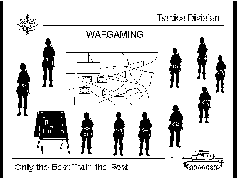
1
- 1. INTRODUCTION:
- SLIDE 1: DST/WARGAME a. Lesson Tie-in: We have talked previously about the need for synchronization. In this class we will show you one of the tools the S2 uses to help synchronize his efforts with those of the rest of the staff and the S3 in particular. We will also look at ways to evaluate the courses of action both friendly and enemy that you developed earlier. Wargaming needs to be conducted honestly with a strong adversarial enemy player. Prior to World War II, the Japanese wargamed the attack on Pearl Harbor and discovered that one of its Sequels would be an engagement near an island called MIDWAY. This engagement resulted in two Japanese aircraft carriers being sunk by US carriers. A halt was called in the game. Screaming admirals insisted that the Americans could never sink a Japanese carrier and forced the umpires to refloat the ones that had been sunk. This comes under the heading of "lessons lost."
- b. Objective: As a result of this instruc-tion, students will, in an all-source intelli-gence environment, be able to apply the principles of a decision support template to a defensive scheme of maneuver IAW the current graduation criteria.
- c. Safety Considerations: There are no specific safety consideration for this block of instruction.
- d. Purpose: You must be prepared to present intelligence information to the commander and the S3. One of the principle means of doing this is through the DST and the wargaming process. This class is intended to assist you in being able to apply everything you have learned to date in tactical intelligence and in threat to a wargame.
- e. Procedure: You will be given detailed
- Note: Use assistant instruction on how to wargame and prepare
- instructors to assist a decision support template.
- the PEs and to take After two hours of instruction, you will be
- briefings. given six hours to wargame the friendly and enemy courses of action you have developed.
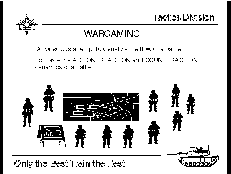
2
SLIDE 2: DEFINITION 2. DEVELOPMENT:
- a. WARGAMING: Wargaming is a conscious attempt to visualize the flow of a battle, given friendly strengths and dispositions, enemy assets, and possible courses of action, and a set piece of ground. Wargaming is a method of analyzing friendly courses of action. We will come back shortly to explain how to use wargaming to develop the DST. A properly wargamed DST tells subordinates WHAT to do and results in a mission type order. A Mission Type Order is used to distinguish a brief type of order that, for instance, tells the engineer "conduct countermobility along PL Red" from one which would detail individual obstacles in order of priority. It is the difference between telling subordinates WHAT to do and HOW to do it. We believe it is possible to go through the command estimate process very rapidly by proceeding from mission analysis to wargaming a single course of action and from there directly to the production of the order. TIME IS NEVER TO SHORT TO DELETE WARGAMING. THIS IS HOW WE SYNCHRONIZE THE BATTLE.
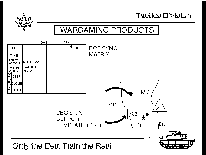
3
SLIDE 3: PRODUCTS b. The two major products that will come out of wargaming will be the Decision Support Template (DST) and the Synchronization Matrix.
(1) The Decision Support Template
(a) The Event Template provides the basis for the DST. The DST is essentially a combined intelligence estimate and operations estimate in graphic form. It relates the detail of the event template to decision points that are significant to the commander, and identifies critical battlefield areas, events and activities which require tactical decisions by time and location. The DST does not dictate decisions to the commander, but indicates points where a decision may be required.
- (b) Development of the DST is the function of the commander's targeting team, the G2/S2, G3/S3, and the targeting officer (FSCOORD/FSO). However, to be complete and effective, the DST must be developed as a result of a total staff effort. The G4/S4, Air Liaison Officer, S3 Air, ADA staff officer, Engineer staff officer, Intelligence and Electronic Warfare Staff Officer, aviation officer and NBC officer all have roles to play. The most effective way to bring the staff together and get input to the DST is in wargaming. The DST cannot be complete until wargaming has taken place.
- (c) The DST is used at several points during the command estimate process.
- The S2 develops an event template which summarizing his intelligence estimate prior to wargaming to use as a tool during the wargame.
- (d) The DST is highly variable, shaped by the needs and desires of the commander and his staff. Some things will always appear, though. These are Time Phase Lines, Decision Points, Target Areas of Interest, and the Synchronization Matrix. Other things may appear such as friendly and enemy avenues of approach and counterattack avenues, key terrain, friendly and enemy objectives, the current enemy situation or situational template of an enemy course of action. The S2 in summarizes the intelligence estimate graphically with the situational template which helps him explain enemy courses of action to the staff.
- (e) Time Phase Lines. You learned about TPLs in IPB when doing the Event Template. TPLs represent the movement of forces over time. They can be computed for many different purposes and used in figuring the relationship of events in time in the Close, Deep, and Rear Battle. When preparing the DST for the close battle trace the TPLs for the close battle from the event template.
- DEFENSE. When friendly forces are defending in the close battle enemy TPLs are drawn in red and represent the the location of the lead elements of the enemy main body at a specific point in time. Since we do not know the exact time of the enemy attack, we will name our TPLs in terms of hours before and after H hour (H+ and H-) with H hour being the point at which our command first makes contact with the enemy, normally coinciding with the Battle Handover Line (BHL)
TPLs in the defense reflect enemy doctrinal rates of advance adjusted for the terrain and
conditions. TPLs representing the friendly counterattacks must be shown. These are drawn in blue. - OFFENSE. When friendly forces are in the offense, TPLs are drawn in blue and represent the location of lead elements of the friendly main body. Enemy counterattacks are shown in red TPLs. The time that the friendly force crosses the Line of Departure and makes contact with the enemy is known, so actual hours (0430, 1300, etc) can be used in conjunction with the TPLs. Since there is no doctrinal rate of advance for friendly forces, the S2 may use one of the published charts to approximate movement rates or turn to the S3 for information as to how fast he plans to move.
- ADJUSTMENTS. The S2 must be prepared to adjust time phase lines both during the battle as actual times become known and during wargaming. Movement rates are METT-T dependant. The doctrinal rate of advance for the enemy may be 2 KPH in the MBA, but if the plan calls for friendly forces to stop him in one area and allow him to penetrate in another, the TPLs must be adjusted accordingly. When considering enemy courses of action, never forget the E in METT-T; always consider what the enemy commander's ENEMY (the friendly force) is doing -he does.
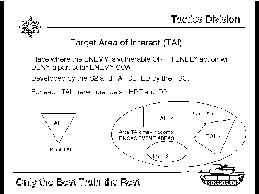
4
SLIDE 4: TAIs
- (f) Target Areas of Interest (TAIs). The area here we can delay, disrupt, destroy, or manipulate the enemy force by attacking the enemy's HVTs are identified as Target Areas of Interest (TAIs). A TAI is an engagement point or area, usually along an avenue of approach or mobility corridor, where the interdiction of an enemy force by fire, maneuver, or jamming will reduce or deprive that force of a particular capability. From the standpoint of the Intelligence Estimate TAIs may correspond to Enemy Vulnerabilities.
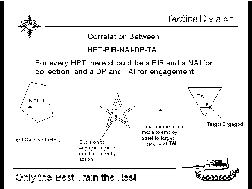
5
SLIDE 4: HPT-PIR-NAI-DP-TAI When the commander chooses to attack an HVT in a TAI the HVT becomes an HPT. When an enemy force or element is attacked in a TAI a vulnerability is exploited. TAIs are a short-hand for factors that will be shown as other things on other graphics. On the operations overlay, TAIs may correspond to engagement areas or objectives. On the engineer overlay, TAIs may correspond to targeted bridges, to obstacles and other engineer targets. On the fire support overlay, they may correspond to targets or target groups and series. TAIs are numbered for reference. TAIs can be identified either as point or area TAIs.
- POINT TAIs designate specific target areas for fire support, engineer or EW assets. They are normally used in conjunction with assets which require at least a moderate degree of accuracy to be effective.
- AREA TAIs are normally more terrain-dependant and are used with assets which are employed over a larger area -maneuver forces, CAS, Battlefield Interdiction (BI), and attack helicopters. They are depicted by a box outlining the TAI with the letters TAI and a number inside.
- CHOOSING A TAI. Only the commander can decide to attack an HVT, thereby designating it an HPT. The S2 describes HVTs. He may recommend TAIs -places and times to attack HVTs -based on enemy vulnerabilities to attack a specific places and times. The S2 may show his recommended TAIs based on enemy vulnerabilities. The S2 must be aware, however, that the decision to attack specific HVTs at specific places and times is in fact a description of the friendly course of action. TAIs must be selected and developed during wargaming in relation to the friendly course of action.
- ELEMENTS OF A TAI. TAIs must correspond to an HVT vulnerable to attack at a specific place and time. The elements are: 1) an HVT, 2) attack means (fire support, maneuver forces, etc), 3) a specific place, 4) a specific time.
- (g) Decision Points (DPs). After TAIs are selected, DPs are identified. The selection of DPs is primarily a G3/S3 function. DPs identify events, areas, and points on the battlefield where tactical decisions are required, and when these decisions must be made. DPs do not dictate decision to the commander: they indicate only where tactical decisions should be made in order to have the most effect on the enemy. Decisions must be made early enough to have the desired effect on the enemy. However, they cannot be made until there are indicators that particular battlefield event will occur. Time is the critical factor in placing DPs.
- TIME: The staff works backwards from the TAI adding time to time to determine placement of the DP:
- TIME required to receive the information that the event has occurred from the intelligence collection or surveillance asset monitoring an NAI.
- TIME required to process the information.
- TIME required to advise the commander of the activity and get his decision. This corresponds to the physical location of the DP.
- TIME it will take to bring the various assets on target at a TAI after a decision is made.
- If an NAI is drawn on the overlay depicting the point at which an enemy activity that will trigger our action at a TAI, and the TAI is drawn showing where we will attack the enemy, the DP should appear somewhere in between. DPs are drawn at a point representing the last possible point at which the commander can make his decision to attack the enemy at a TAI.
- DPs FOR EVENTS NOT RELATED TO THE CLOSE BATTLE. In theory, one would make a separate DST for close, deep, and rear battles. In practice, at tactical echelons, only one DST is drawn depicting the close battle. Decision Points for the deep, rear, and security battles may not fall neatly between NAI and TAI. The time phase lines, as we have seen, will not be synchronized to these battles and the time relationship of the DPs is also lost. A technique for dealing with this is to show the DPs for the deep and rear battles at the related NAI and record where they occur in time in the synchronization matrix.
- GRAPHIC DEPICTION. DPs are shown as a star with a number in it.
- DECISION POINT CLUSTERS. A series of decisions may be needed to execute a certain mission. For example, a Close Air Support (CAS) mission will require decisions in the timeliness of the asset, the ADA weapons status, artillery and IEW jamming assets. All these decision would make up a Decision Point Cluster.
- (2) The SYNCHRONIZATION MATRIX. The synchronization matrix is often appended to the bottom of the decision support template. It allows us to synchronize the activities of the seven Combat Functions. The matrix is a listing of the seven systems showing their activities at different times. You have studied these in previous classes. In the synchronization matrix you will record: 1) Mission Type Orders to the systems, 2) Decision Points effecting them, and 3) Target Areas of Interest where they will effect the enemy. Briefly, they are:
- (a) Maneuver. Maneuver includes Light, Airborne, Air Assault, and Mechanized Infantry as well as Armor, Armored Cavalry, Air Cavalry and Attack Helicopters.
- Maneuver is also subdivided into in accordance with the Battlefield Framework.
- Deep, Close, and Rear Battle Operations.
- Eventually our course of action and scheme of maneuver (in the OPORD) must address each of these areas.
- (b) Intelligence. Intelligence makes a contribution through its collection effort, jamming effort and through answering PIRs. S2 takes some information from the wargame. Obviously much preparation is implied.
- (c) Fire Support. This includes all indirect fire means including Close Air Support and Air Interdiction. The priority of fires is given and changed in this block and HPTs to be attacked by Indirect Fire are listed here.
- (d) Air Defense. This includes Air Defense Artillery and all weapons systems firing at aircraft. The ADA Weapons Status and Warning are given in this block as well as the priority of protection.
- (e) Mobility/Countermobility/Survivability. This block addresses the Engineer contribution to the battle as well as Survivability tasks undertaken by elements other than engineers: camouflage and smoke operations and the MOPP. In this block the engineers are given their priority of work and priority of support.
- (f) Combat Service Support. In this block those actions that CSS will have to take during the mission are addressed: refueling, rearming and prestocking ammunition. NBC Decon operations are also addressed here.
(g) Battle Command. In this area movements of Command Posts and other activities directly related to C2 are recorded.
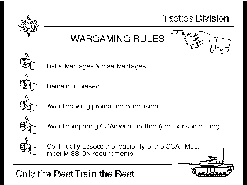
6
SLIDE 5: WARGAMING RULES
The rules for wargaming are established to ensure that everything that will impact on the battle is included.
(1) List all advantages and disadvantages
(2) Remain unbiased
(3) Avoid drawing premature conclusions
(4) Avoid comparing COAs
(5) Continually assess the feasibility of the COA. Any time it fails to meet mission requirements it must be discarded.
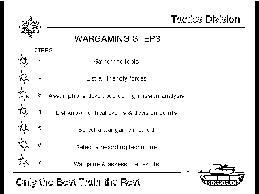
7
SLIDE 6: WARGAMING STEPS
- (1) Wargaming steps.
(a) Gather the Tools
(b) List all Friendly Forces
(c) List Assumptions from Mission Analysis
(d) List Known Critical Events and DPs
(e) Select a Wargame Method
(f) Select a recording Technique
(g) Wargame and Assess the Results
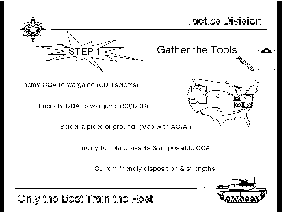
8
- SLIDE 7: STEP 1 * 1. Gather the Tools.
- Commander selects the enemy COAs he desires to wargame.
- Select friendly COAs.
- Post the map with AO and AI.
- Post the enemy template to the map (S2)
- Post current friendly unit dispositions.
- S2 Preparation (Gathering the Tools)
- Terrain Analysis
- Enemy Situation and Capabilities including available combat multipliers
- HVTs available to the enemy at any given point in the battle

9
- SLIDE 8: STEP 2 * 2. List All Friendly Forces.
- Should be available from Mission Analysis
- Don't forget CAS, AI and artillery
IF TIME IS SHORT, consider only the forces that will have the highest probability of influencing the outcome. It may be limited to COMBAT UNITS.
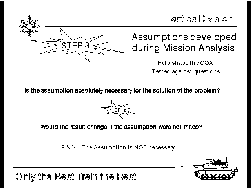
10
- SLIDE 9: STEP 3 * 3. List the Assumptions.
- The validity of each assumption is tested against the question, "Is the assumption absolutely necessary for the solution of the problem?" or "Would the result change if the assumption were not made?" If the answer is "No," the assumption is not necessary. Assumptions may eliminate certain enemy courses of action. One baseline assumption is often that the enemy will attack. This screens out capabilities such as withdraw, retreat, run away, and cross the border to party. Do not assume away enemy options and flexibility, however. Do not assume away the problem or paint an improbable worst case situation.
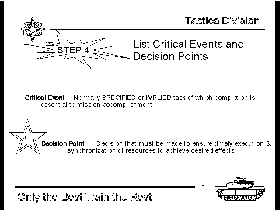
11
- SLIDE 10: STEP 4 * 4. List Known Critical Events and Decision Points.
Critical events are normally those specified or implied tasks the completion of which are essential to mission accomplishment and which the the judgement of the war gamer, require detailed analysis. Decision Points are where dicisions must be made to ensure timely execution of missions and synchronization of resources to achieve desired results.
SLIDE 11: CRITICAL EVENTS Critical Events Include:
- OFFENSE
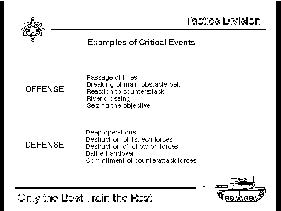
12
- Passage of Lines
- Breaching of main obstacle belt
- Penetration of defensive positions and/or belts
- Reaction to counterattack forces
- River Crossing
- Seizing the objective
- Use of Reserves
- Deep Operations
- DEFENSE
- Deep Operations
- Destruction of first-echelon forces
- Destruction of follow-on forces
- Commitment of counterattack forces or reserve
- Battle Handover
- Other critical events and decision points may be determined during the wargame. For instance, if we are defending, critical events we have listed for the offense when taken from the enemy perspective may be points of vulnerability for the enemy that are critical to us as well.
- There will be times when the list of critical events and decision points may be too long to manage. The analyst must then reduce the list to one that is manageable in the time available for war gaming. This process requires military judgement to determine which have the highest probability of changing the outcome of the battle and then restricting the wargame to only those key critical events and decision points. The critical events are what we will wargame. The implication is that events in between critical events will work out well if the critical events are taken care of properly. These are the points at which we will focus our synchronization efforts.
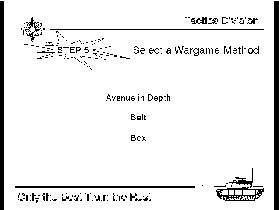
13
- SLIDE 12: STEP 5 * 5. Select a Wargame Method. In previous classes (Course of Action Development) we talked about the three methods:
1) Avenue in Depth
2) Belt
3) Box
SLIDE 13: AVENUE IN DEPTH 1) Avenue-in-depth
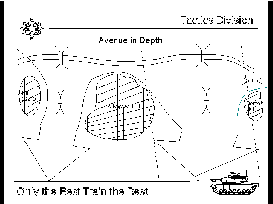
14
We use this method to look at all the forces that will attack our forces along a particular avenue of approach. This includes all reinforcements.
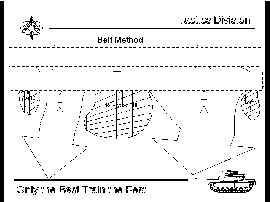
15
SLIDE 14: BELT 2) Belt
We use the belt method to look at all the forces at a particular time in the battlefield. What is happening at H hour? What is the force ratio at H+1? This allows the commander to look at all the forces that will be moving into his sector at any time.
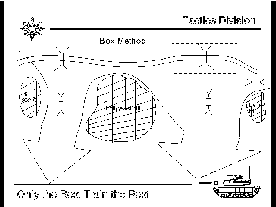
16
SLIDE 15: BOX 3) Box
We use the Box method when we want to concentrate on a small portion of the battlefield. This allows the commander to look closely at individual critical events.
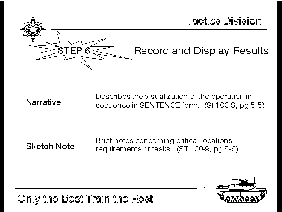
17
- SLIDE 16: STEP 6 * 6. Select a Technique to Record and Display the Results.
There are two methods: Narrative and Sketch.
Narrative: Describes the sequence of events in sentence form.
Sketch: Describes the sequence of events in in a series of brief notes concerning critical locations, requirements, or tasks.
We are going to use the DST as our technique of recording and displaying results. To do that we will make some minor modifications. First, in order to be ready for the Wargame, the S2 should have the following posted to the DST:
- Time Phase Lines
- Known Decision Points
- The Enemy Situation
- The Synchronization Matrix
- We will have him modify the synchronization matrix (prior to the wargame) by adding the following two lines to the top:
- Enemy Reaction
- Critical Events
- At the beginning of the wargame, the S3 will name the critical events to be wargamed. The recorder (Asst S3, or S2) will write the name of each critical event under the TPL the corresponds to when we expect that event to take place. The S3 will also name the wargaming method at this point.
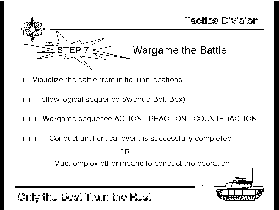
18
- SLIDE 17: STEP 7 (2) Wargaming: Wargaming consists of considering three elements:
ACTION, REACTION, COUNTERACTION:
- ACTION: Identify what friendly maneuver forces are doing: Attacking, defending with a certain number and type of companies.
- REACTION: Identify what the opposing force is doing in relation to the action above. Look at all of the opposing force's committed and reinforcing forces and consider all of his combat multipliers. Don't read "reaction" as things he is doing because we are taking the action above; read it "in relation to friendly action." In one sense reaction is action from the enemy standpoint.
- COUNTERACTION: Identify those actions friendly forces will take in reaction to the enemy reaction. Ask, "What combat multipliers will we use to improve our force ratios?"
- RESULTS OF THE WARGAME:
- Refinements or modifications to the course of action. Changes in composition and location of main effort to improve force ratios. Changes in the use of reserves. Adjustments to control measures to focus combat power at critical points and times.
- Tasks to subordinate units.
- An estimate of battle duration at each critical event and for the entire battle.
- Advantages and Disadvantages of a particular course of action.
- An estimate of kilometer loss or gain.
- A projection of the percentage of total enemy force defeated in each critical event and overall.
- Additional critical events.
- Identification of required use of other combat capabilities.
- Nuclear and/or chemical effects.
- Additional requirements for combat support.
- Requirements for deception and surprise.
- Branches: Branches result from wargaming a friendly course of action against other possible enemy courses of action.
- Sequels: Sequels establish general dispositions, objectives and missions for subordinate units after the battle. They are arrived at by considering all reasonable outcomes of your course of action (victory, defeat, stalemate).
- Let's look at this in more detail.
- ACTION: We will define this as friendly Maneuver action. The S3 will explain what maneuver forces are doing at this critical event. The statement should be simple: "I am attacking (or defending) with 2 M2 and 1 M1 Company." At the time corresponding to the critical event in the synchronization matrix, the recorder records "2 M2, 1 M1 Co".
- REACTION: Reaction is what the enemy is doing about the friendly action. It is always enemy action. The S2 provides this information. It may be looked on as a list of HVTs that the enemy has in use at this point in the battle. Be sure to cover all battlefield operating systems from the enemy's standpoint. In another sense, this also corresponds to a paragraph 3 and 5c and d of the intel estimate specific to this critical event. The S2's response might look like this:
- "S3, within the box you have defined at this critical event the enemy will be defending with 1 MR Co and a tank platoon both at 50% strength and a BRDM2-AT5 platoon; 1 mortar battery 120mm, 1 D-30 battalion and 2 2S5 Bns will fire for him; he will have 4 SA-7s and 2 ZSU 23-4 air defending; 6 HIND-Es are available to reinforce his defense; he is likely to use chemical weapons as soon as we penetrate his first obstacle belt; his engineers will have minefields and anti-tank ditches at these points on the map."
- In the Enemy Reaction line at the appropriate time, the recorder records the HVTs:
- 1 MR CO, 1 TNK PLT, AT5 50%
- 1 MTR BTY, 1 D-30 BN, 2 2S5 BN
- 4 SA-7, 2 ZSU 23-4
- 6 HIND-E
- CHEMICAL
- GMZ, IMR
- At this point the S2 and S3 should stop to figure the correlation of forces; relative combat power on each side. The ratio will also be recorded.
- COUNTERACTION: Counteraction consists of the staff presenting what they can do to neutralize, limit or delay the enemy's reaction. They are in response to the reactions the S2 has presented. The S2 and the S3 will have additional input but initially we will look to the rest of the staff. Counteractions will be recorded at the point they will have to begin in order to be complete/or have their effect at the critical event. For instance, the Chemical Officer says: "If the enemy is going to use chemical, we need to raise our MOPP from MOPP 0. I recommend MOPP I at LD/LC, and since it will take five minutes to go from MOPP I to IV and we don't want to make the change under fire, that we go to MOPP IV 20 minutes prior to the critical event."
- If this is accepted, the recorder, records MOPP I under the TPL the corresponds to the LD/LC on the Mobility, Countermobility, Survivability line and MOPP IV at a point on that line corresponding to 20 minutes prior to the critical event.
- On the other hand, the commander might say: "I don't want my troops in MOPP IV unnecessarily; S2, can you determine with certainty when and where he will use chemical?" In the matrix we record at 20 minutes prior to the event: "ANS PIR 1." The S2 notes that PIR 1 is "When and where will the enemy use chemical?" The recorder puts DP 1 (a numbered star in the DST) and records on the M/CM/S line "DP 1 CHG MOPP IV."
- The FSO says that he can limit enemy direct fire weapons with Smoke and WP. We determine that we will be within the enemy's direct fire range fan 15 minutes prior to the critical event. The S2 notes where the principle weapons systems will be and we record these as TAI 1 thru 6. This is where the FSO will shoot 15 minutes prior. On the
Fire Support line the recorder notes 15 minutes prior to the critical event "SMOKE TAI 1 THRU 6." The enemy systems (HVTs) we are attacking have now become HPTs.
- The FSO also notes that the lead company, Co A, our main attack, will be in the best position to direct artillery fires. So we also record "PRIORITY OF FIRES TO CO A."
- We continue until we have suppressed, limited or delayed all of the enemy's reaction or as much as we can.
- MODIFYING THE COURSE OF ACTION: If we don't reach a point where we feel we can defeat the enemy as a result of our action and counteraction, we may at this point abandon our course of action, or more likely if time is short modify it to provide more focused combat power or more combat multipliers.
- COMPLETE THE WARGAME: Complete the wargame by gaming the remaining critical events in the same manner.
- WARGAME AGAINST OTHER ENEMY COAs: A friendly course of action may have been created to defeat a specific enemy course of action, but in order for us to select a course of action to turn into an order it should be capable of defeating all probable enemy courses of action. To determine this we wargame all enemy courses of action against our friendly course of action. The simplest way to do this is to retain the DST we used for the first wargame and record the results of the second wargame in a different color: say black for the first wargame and blue or red for the second and third.
- You will find that subsequent wargames go much faster than the first. Many actions and reactions will be the same or very similar. There will be no need to record a change since there is none. You will also find that the new enemy course of action may force the commander to make decisions: Do we send the reserve to point A or point B? Some of these will become adjustments that we make to the course of action; many others will require decisions during the battle. These will be reflected with decision points in the DST and matrix. They will result in BRANCHES.
- The S2 must also remember the enemy equivalent of branches. If we neutralize, delay or limit some of the enemy's HVTs, we must remember that he has FAILURE OPTIONS. These will result in
modifications to the enemy course of action even as we wargame it. For instance, the enemy might be attacking to cross the FULDA River. We identify as an HVT his GSP ferries and attack them successfully as an HPT. The S3's next critical event is our counterattack into an objective four kilometers to our side of the river. The S3 says, "Hey, we stopped him at the river; I guess that finishes this wargame." The S2 needs to respond, "No, if he doesn't make it with the GSPs, he'll bring up his bridges; it'll take him one hour to bring up the bridges and a half hour to put them in." This also generates a Branch.
- PREPARATION: When preparing the synchronization matrix and aligning it with the time phase lines, leave one third of the space in the matrix to the side of your TPL corresponding to H hour for actions taking place prior to the start of the battle. This will allow you to conveniently record actions that must be taken prior to the beginning of the battle. The S2 and S3 must be prepared to Wargame.
Terrain Analysis for the AO and AI
Enemy Situation and Capabilities
HVTs for each critical event
TPLs and Synchronization Matrix (blank)
Possible Enemy Courses of Action
Friendly Courses of Action
Friendly Forces Available
Combat Multipliers
Assumptions
Critical Events
Wargame Technique
- FOCUS: Stay focused on the event not on time. Do not try to fill out what each BOS is doing at the time cooresponding to a critical event. Note instead what the BOS's in use are doing at various times to have an effect at the time of the critical event.
- BEGIN PE
- 3. SUMMARY


















